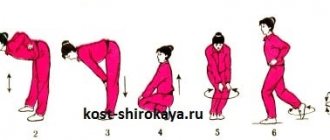© ogichobanov — depositphotos.com
Share:
Almost every athlete knows that it is impossible to grow all the time. Everyone struggles with this in their own way. It was precisely because of the impossibility of constant growth that hard gainers appeared in their time. Have you seen bodybuilders who eat on a schedule and constantly ingest anabolic steroids? Why is all this needed? The answer lies in one word - catabolism.
The essence
Catabolism is a direct component of metabolic processes in the body. What is she like? It’s very simple – it’s resource optimization. Our body works like a pendulum, constantly creating new cells and destroying old ones. In fact, in 5 years you are completely renewed, being a different person. But that's not all.
In a biochemical understanding, catabolism is the breakdown of complex substances into simpler ones or the oxidation of various molecules. The process occurs with the release of energy:
- heat;
- ATP molecules are the main source of energy for any biochemical reaction.
Catabolism and anabolism are in constant balance, and directly depend on the following factors:
- Hormones, since these substances are the main regulators of catabolism and anabolism.
- The need to change the balance.
- Food.
- Metabolic rates.
- Amount of sleep.
- Other factors.
Let's look at a simple example of the processes of optimizing the body's resources. Initially, during the day, the body strives to break down energy and synthesize new cells.
At night, a reboot occurs, and it begins to kill unnecessary cells, breaking them down, and preparing for renewal.
In case of stress loads, catabolic processes are significantly accelerated. However, in this case, the acceleration of catabolism occurs in preparation for a powerful anabolic surge. All cells that are unable to withstand new levels of stress are killed and destroyed, replaced by more powerful and stronger ones.
Loads are precisely the factor that influences the shift in the balance between anabolic and catabolic processes.
When the stress in the body passes (for example, a person stops playing sports), the smart body optimizes resources so that it can survive in the event of a hunger strike or other powerful stress. And we all see muscle breakdown. This is especially noticeable if you follow athletes after their careers end. Usually they lose up to 40% of the accumulated muscle mass.
It is important to understand that physical activity is not the only factor that changes the balance between catabolism and anabolism. Any change in your daily routine or diet can move the slider in one direction or another.
© ogichobanov — depositphotos.com
What happens during the process of anabolism
During energy exchange, matter is created and energy is consumed. As a result of anabolic reactions, complex substances are created. During anabolism, new cells are created and homeostasis of all living tissues of the body is maintained. The body's action is aimed at creating more complex molecules from simple units. The mechanism of anabolic reactions is characterized by the use of several simple substances to synthesize many different end products. Examples of anabolic effects are:
- nutrition of bone tissue for their growth, restoration, development;
- increase in muscle mass;
- wound healing;
- growth of nails, hair, etc.
Due to anabolic processes, monomers are converted into polymers - large molecules with a complex structure, including many miniature building units that are similar to each other. For example: amino acids (monomers) as a result of a series of anabolic chemical reactions form proteins, which are large complex molecules with a three-dimensional structure (polymers).
- How to use a compass correctly
- How to use facial concealer
- How to attract a man
The meaning of anabolism and catabolism
Energy metabolic reactions play a very important role for humans, and the body can maintain its normal state only if anabolism and catabolism are in balance. When one of the bioprocesses is suppressed, a violation of the second is inevitable, since they are closely related. An imbalance of energy metabolism can cause various diseases, hormonal imbalances and, as a result, a strong gain of fat, or the reverse process will start and excessive weight loss will occur.
Catabolism is responsible for breaking down muscle tissue and other elements to produce energy. The reaction is triggered during stress, poor sleep, sports training, fatigue, hunger. At the same time, the body produces the hormone cortisol, which destroys muscles, thereby activating the accumulation of fat and increasing glucose levels. These phenomena are extremely undesirable for athletes. However, cortisol also has a positive effect on the body: it breaks down muscle amino acids, which is extremely important for human life.
The importance of anabolism and catabolism for human life cannot be overestimated. If you try to artificially suppress catabolic reactions, hormonal imbalances are likely to develop, so you should learn to adhere to the correct daily routine and control muscle development. This can be achieved if you provide your body with proper rest, lead a healthy lifestyle, choose a balanced diet and competently create a training program. In addition, experts advise athletes to use dietary supplements and vitamins.
Physiology
The physiology of catabolism consists in the breakdown of substances followed by their oxidation. During metabolic processes, any activity provokes the onset of a general path of catabolism. During a stressful situation (muscular/mental tension), the body begins to consume huge amounts of glycogen. Subsequently, if there is sufficient oxygen in the blood, the breakdown of ATP in muscle tissue occurs, which provokes destruction and microtrauma of muscle tissue.
Note: Catabolism is not always a bad thing. After all, the process concerns not only muscle, but also adipose tissue. In particular, many diets and training complexes for cutting imply the activation of catabolic processes to remove lipids from insulin-opened cells, followed by their breakdown into energy and oxidation.
Fermentation
Examples of fermentation processes are known from everyday life and industrial activities.
- Alcoholic fermentation involves the metabolic transformation of carbohydrates by microorganisms, mainly yeast. As a result, ethyl alcohol, ATP and water are formed, and carbon dioxide is released. Microorganisms use energy for life and cell division. Alcoholic fermentation is used in the production of alcoholic beverages. Baker's yeast in bread baking also converts carbohydrates into ethanol and carbon dioxide, which loosens the dough.
- Lactic acid fermentation ends with the formation of molecules of lactic acid, ATP, hydrogen and water. This is how milk sours, producing buttermilk, yogurt, sour cream, and cottage cheese. (Picture 1).
The same type of fermentation occurs when cabbage is sauerkraut. Lactic acid bacteria reduce the pH of the substrate and create an acidic environment. They do not require oxygen, but survive in an oxygen environment. - Acetic acid fermentation leads to changes in juice and wine. First, ethanol is produced as a result of alcoholic fermentation. Then, acetic acid bacteria process the alcohol into organic acids, mainly malic, citric, and lactic. This is how natural vinegar is obtained from fruit and berry raw materials.
In all cases of fermentation, microorganisms change carbohydrates and produce a macroenergetic substance - ATP. This process does not require oxygen, which is a major difference from breathing. A common feature is that the chemical energy of the bonds in the glucose molecule is converted into energy in the form of ATP, which is used for life processes.
Fermentation is the oldest and not the most perfect way to produce energy. One molecule of glucose produces 2 molecules of ATP. The oxygen process is more efficient in terms of energy production.
Organisms that require oxygen to breathe are aerobes (translated from the Greek “aer” - air). The external side of the process is the absorption of oxygen from the air and the release of carbon dioxide.
O2 molecules enter the insect body through the trachea. Fish are characterized by gill respiration, while mammals are characterized by pulmonary respiration. Red blood cells containing hemoglobin carry oxygen to organs and transport carbon dioxide.
In the absence of oxygen, fermentation begins to occur. Fermentation is an evolutionarily earlier way of generating energy than respiration, but it is less energetically beneficial because fermentation produces organic matter that is still rich in energy. There are several main types of fermentation: acetic acid, alcoholic, butyric acid, lactic acid, methane, etc.
Therefore, in skeletal muscles, in the absence of oxygen during fermentation, pyruvic acid is reduced to lactic acid, while the previously formed reducing equivalents are consumed, and only two ATP molecules remain:
2C3H4O3 + 2NADH+H+
→
2С3Н6О3 + 2NAD.
During fermentation with yeast, pyruvic acid is converted in the presence of oxygen to ethyl alcohol and carbon monoxide (IV):
C3H4O3 + NADH+H+
→
C2H5OH + CO2
↑
+ NAD+.
During fermentation using microorganisms, pyruvate can also form acetic acid, butyric acid, formic acid, and so on.
ATP energy, which is formed as a result of energy metabolism, is used by the cell for various types of work:
- Chemical work involves the biosynthesis of proteins, lipids, carbohydrates, nucleic acids and other important compounds.
- Osmotic work involves the processes of absorption and removal of substances from the cell that are in the extracellular space in higher concentrations than in the cell itself.
- Electrical work is inextricably linked with osmotic work, because it is due to the movement of charged particles through membranes that the charge of the membrane is formed and the properties of excitability and conductivity are acquired.
- Mechanical work is associated with the movement of substances and structures in the intracellular space and the cell itself as a whole.
- Regulatory work includes all processes that are aimed at coordinating procedural actions in the cell.
Stages
Since catabolism is a cyclic procedure, it has active and passive phases combined with anabolism. Let's take a closer look at the stages of catabolism:
- Stage one is stress.
- Stage two is destruction.
- Stage three – super recovery.
- The third alternative stage is optimization.
- Stage four – balance.
From the first stage, the body begins to actively consume reserve resources. Stress is considered to be almost all human activity that goes beyond his usual daily routine. Thus, muscle catabolism can provoke:
- Changing your daily routine, reducing sleep.
- Unusual strain on muscles.
- Changing your meal plan.
- Increased consumption of adrenaline stimulants.
In the process of receiving stress, the body begins to destroy reserve resources (starting from glycogen reserves, which are also stored in muscle tissue, and ending with the muscles themselves). If the body has reserve sources of energy or timely replenishment is provided, then the process of super recovery begins.
Interesting fact: have you noticed that during mental stress, the body actively requires sweets? Or the fact that girls eat away all their problems and sorrows with cakes and sweet tea. So, this is a consequence not only of the presence of “pleasure hormone” stimulants, but also a natural need of the body to restore strength and prepare the body for possible stress.
If the body does not have reserve funds for recovery, then the optimization stage begins. At this moment, the synthesis of ATP and glycogen stops, and the body itself reduces energy consumption due to the destruction of energy consumers.
The most important energy consumers are the muscles and the brain.
Conclusion: fasting causes not only a decrease in muscle mass, but also brain destruction. Therefore, people who are constantly in a calorie deficit actually become dumber than their well-fed counterparts.
After optimization (super-recovery) is completed, the body brings anabolic and catabolic processes into balance. This stage usually takes up to 48 hours while the body stabilizes.
Note: For the same reason, people not taking anabolic steroids should take at least 48 hours between workouts.
Catabolism processes include:
- tissue oxidation;
- change in ATP balance;
- cessation of ATP synthesis;
- breakdown of amino acids into energy.
- changes in lipid balance;
- change in the size of glycogen depot.
This is not all that happens during catabolism.
In general, in biochemistry, the stages of the general catabolic pathway are as follows:
- Digestion in the gastrointestinal tract is a chain of reactions that convert complex molecules into simpler metabolites. This is how glucose, fatty acids, and amino acids are obtained.
- Specific catabolic pathways are the breakdown of simple metabolites to pyruvic acid or acetyl-CoA.
- Oxidative decarboxylation of pyruvate, citrate cycle, respiratory chain - the final stage of catabolism, as a result of which final products are formed from food components (source - Textbook “Biological Chemistry”, Severin).
The biochemical processes are quite complex, and in each case, catabolism occurs individually.
Energy and plastic metabolism, their relationship
Metabolism is procedurally composed of two parts that occur in the cell at the same time: plastic and energy metabolism .
Plastic metabolism (anabolism, assimilation) is a set of synthesis reactions accompanied by energy consumption of adenosine triphosphate. Plastic metabolism is especially important because it results in the synthesis of organic substances that play an important role in the life of the cell. The reactions of this exchange are, for example, the process of photosynthesis, the biological synthesis of protein molecules and the replication of DNA molecules (self-duplication).
Energy metabolism (catabolism, dissimilation) is a combination of reactions of decomposition of complex substances into simpler ones. The result of this exchange is the accumulation of energy in the form of ATP. The most important processes of energy metabolism are respiration and fermentation.
Plastic and energy exchanges strongly correlate with each other, due to the fact that the synthesis of organic substances occurs in the process of plastic exchange, and this requires ATP energy; During the process of energy exchange, organic substances are decomposed and ATP is released and then used for synthesis.
Energy is obtained by organisms during the process of nutrition, then it is released and converted into a form available mainly during the process of respiration. According to the method of nutrition, all organisms are divided into autotrophic and heterotrophic. Autotrophs are capable of independently synthesizing organic substances from inorganic ones, while heterotrophic organisms absorb ready-made organic substances.
Assimilation is the biosynthesis of macromolecules characteristic of the cells of the body. Plants and many bacteria can create glucose molecules from carbon dioxide and water. This process consumes and stores energy. Animals need ready-made molecules of proteins, fats and carbohydrates (BJU). This is the most important building and energy material for cells.
Assimilation is a set of processes of creating body structures with the accumulation of energy.
Metabolism value:
- Receipt from the external environment of substances necessary for the body;
- Converting nutrients into compounds that can be used by cells and tissues;
- Synthesis of structural elements of cells, enzymes, etc., replacement of obsolete ones with new ones;
- Synthesis of more complex compounds from simpler ones;
- Deposition of reserves.
In order for the body to absorb substances from food, they must first be broken down into “building blocks” or monomers. From these, the body “assembles” its own macromolecules.
Dissimilation is the breakdown of substances, the opposite of assimilation (biosynthesis). Proteins are hydrolyzed to amino acids. When fats break down, fatty acids and glycerol are released. Complex carbohydrates break down into simple sugars.
Assimilation and dissimilation occur in concert. The decomposition and oxidation of substances with the release of energy is possible only when there is a substrate - macromolecules. They decompose into monomers that participate in biosynthesis. The energy released during dissimilation is spent on the formation of substances characteristic of the body.
How to slow down?
Considering the specific and general pathways of catabolism, we can conclude that it is impossible to stop catabolism. At the same time, you can look for ways to slow it down.
The rate of catabolism is directly related to the rate of metabolism. Despite the fact that people think that a slow metabolism leads to weight gain and leads to catabolism, this is not entirely true. Therefore, if your goal is to slow down catabolism, there are 3 main ways:
- Increase the time of anabolic processes.
- Reduce stress on the body.
- Slow down metabolism.
To increase anabolic processes, you need to constantly feed the body with energy and builders.
That is why experienced bodybuilders eat 5-8 times a day, strictly at certain times.
To increase the time of anabolic processes, you need to eat hard-to-digest foods (complex carbohydrates, rich in fiber), and consume at least 2 grams of protein per kilogram of net weight.
Reducing stressful situations for the body is easier to achieve. Don't move, sleep and feel joyful emotions. A day off/vacation/break between workouts can help with this. 8 hours sleep, and a bar of dark dark chocolate.
Slowing down metabolism is extremely easy to achieve - you just need to create a situation in which metabolic processes slow down extremely. A good way is to sleep a lot. A bad way is to stop eating.
Metabolism concept
Metabolism can be defined as a set of biochemical processes occurring in any living organism, including the human body. Metabolism is needed to ensure the vital functions of organs and systems, and these chemical reactions allow us to grow, adapt to environmental conditions, heal wounds, reproduce, etc. Metabolic processes are divided into two types:
- assimilation (constructive processes or anabolism);
- dissimilation (destructive processes or catabolism).
Products to slow down catabolism
As we mentioned earlier, in sports disciplines it is important to maintain the right balance between anabolism and catabolism.
However, you don’t have to take anabolic steroids for this. It is enough to use products that reduce the rate of catabolism, thereby provoking a positive balance of anabolic processes in relation to catabolism.
| Product | Impact principle |
| Ginger root | Is a direct stimulator of androgen hormone production |
| Caffeine | Is a powerful adrenaline stimulant |
| Lemon | Vitamin C – slows down the processes of oxidation and muscle breakdown |
| Meat | Protein structure that allows you to shift the balance of anabolism relative to catabolism |
| Eggs | Protein structure that allows you to shift the balance of anabolism relative to catabolism |
| Milk | Protein structure that allows you to shift the balance of anabolism relative to catabolism |
| Tribulus | Is a direct stimulator of androgen hormone production |
| Complex carbohydrates | Stops the breakdown of muscle structures for energy |
| Polysaturated omega 9 acids | Are harbingers of cholesterol |
| Products containing healthy cholesterol | Cholesterol – allows you to significantly increase the production of anabolic hormones, reducing the level of catabolism to almost zero |
What it is?
This term is often used by bodybuilders, especially when training beginners. What is catabolism, is it dangerous? Catabolism (the opposite process is anabolism) is the breakdown of substances, structures, muscles. However, amino acids and glucose formed during this process are an integral part of it. The breakdown of carbohydrates as a source of energy and fats is also catabolism. Here the energy that the body needs to exist is released. Therefore, the process of catabolism is necessary for the body, but it can be both beneficial and harmful.
For sports, protein breakdown or protein catabolism (muscle) is of particular importance. This type of catabolism breaks down muscles. This process must be prevented and suppressed. There are a number of rules, following which you can achieve the desired result.
The beauty of the body and athletic figure depend on muscle tissue. It is not enough to go on a diet to lose weight. This must be done correctly, and do not forget about physical activity. After all, improper weight loss and the launch of the catabolism process threatens to slow down metabolism. Processes occur here that negatively affect the muscles. For example, during catabolism, glucose is phosphorylated, which affects skeletal and muscle fibers.
Therefore, if you want to build muscle mass, you need to suppress catabolism and trigger anabolism, which is necessary for the synthesis of new structures and muscle growth.











